
About the "Ideal Viewing Environment"
Viewing environment principles are discussed and demonstrated on Joe Kane Productions' 'Digital Video Essentials' DVD, in Title 2, Chapter 2, "Room Environment. Additional information can be found on Ovation Software's 'Avia Guide To Home Theater'. See: chapter 7, Home Theater Environment, Introduction and Background Lighting for Video, and select the "hot buttons" text boxes.
![]()
THE IMPORTANCE OF VIEWING ENVIRONMENT CONDITIONS IN A REFERENCE DISPLAY SYSTEM
THE GOAL:
The author’s purpose in this paper is to enlighten imaging industry professionals and home entertainment consumers in a seldom discussed and little understood dimension of optimum video display system design and installation. It’s the position of this paper that video is fundamentally a mass communication medium. The objective in such a medium is to convey an original message without loss, confusion, distortion or misunderstanding. Video relies upon images more so than words to carry its message. To convey more beautiful pictures is at the heart of the current HDTV revolution. This paper will focus more specifically upon home theater and the faithful reproduction of cinematic art via video displays.
Home cinema has developed into a major form of entertainment, enjoyment, escape, and relaxation for the contemporary consumer. The author recognizes an increasing interest in electronic image quality in our culture today. What follows is intended to better inform anyone curious about how to produce the most beautiful pictures in the home, which our current technology can provide. The practical keys that follow should serve as a guide in insuring that the costly electronic devices used in home entertainment systems will perform optimally, and communicate the art of cinema in the most faithful, beautiful and enjoyable way.
THE THEORY:
Electronic imaging is composed of both science and art. The science of imaging studies both the technologies involved and human perceptual factors. Any fully integrated and comprehensive approach to electronic display system design, installation, and calibration must take into account every component in the system. These components include: electronic device hardware, inter-connect cabling, program signals, room conditions, and last (but far from least) the viewer. A complete study and application of imaging science principles must encompass all of the above components. Ignoring any one of these can result in diminished total system performance. Diminished performance effectively reduces the value of the system.
The viewing environment is the least understood and, therefore, frequently ignored element in proper display system design, implementation and calibration. Viewing conditions always affect display performance, human perception of the image on the screen, and viewer comfort. A properly calibrated display will not be perceived correctly if there are conflicting viewing environment conditions.
The Society of Motion Picture and Television Engineers (SMPTE) is responsible for developing standards and practices for the motion imaging industries. Their recommended practices document, RP166-1995: ‘Critical Viewing Conditions For Evaluation Of Color Television Pictures,’ deals specifically with viewing room conditions and human perceptual factors in reference display environments. SMPTE’s human factors research found that viewing conditions profoundly affect the way video images appear and also impact viewing comfort. Their work applies to all forms of electronic displays and is beneficial for computer monitor use, digital graphics design, digital photography, electronic interactive games, technical, medical, industrial, security applications, home theater, etc.
Professional monitor environments (where critical image analysis is conducted for mastering video programs) use tightly controlled ambient lighting and neutral colored surfaces surrounding the display.
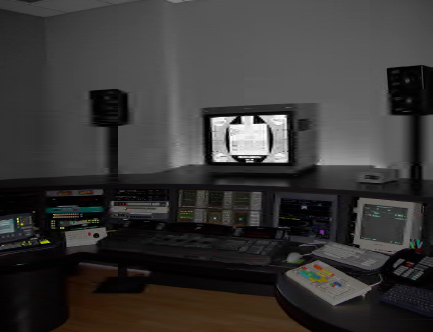
A CRT post-prodution monitor viewing environment (courtesy of Joe Kane Productions)
These room characteristics help preserve correct color perception and image fidelity. It is vital to consider that program post-production can involve multiple days, different technicians, and even various facilities working on the same project.
Such display industry standards are followed to insure unity, consistency, repeatability, quality, and faithfulness to the vision of the producer, all along the production and program delivery chain. In other words, image fidelity and artistic integrity are preserved as long as the rules of the system are followed. This is important for the consumer to understand, since the home entertainment system is the final link in the chain.
The International Telecommunications Union is another standards organization that recognizes the impact of viewing environment conditions upon a viewer’s perception of a display. Their Radiocommunication sector has published a recommended practice document in their Broadcast services (Television) series: ITU-R BT.710-4 "Subjective Assessment Methods For Image Quality In High-Definition Television." This document defines critical viewing conditions for the evaluation of HDTV images. It specifies environmental guidelines such as: horizontal viewing angel, color, orientation and brightness of ambient lighting, color of surrounding surfaces, etc.
Imaging excellence is the result of understanding the principles of imaging science, following display industry standards and practices, plus attention to detail when executing a display installation. Any reference display system design, installation and/or calibration service should include a disciplined attention to every element and component, if image fidelity and artistic integrity are worthy goals.
THE PRACTICE:
Residential viewing environments can be designed or retrofitted to emulate professional viewing conditions, thereby preserving image fidelity and viewing comfort. Here are some important elements and principles to consider:
FOR SELF-CONTAINED DISPLAY TYPES (direct view and rear projection TVs):
- Room lighting must be controlled to avoid screen reflections. Reflections, haze, and glare interfere with the picture. Many viewers are unaware of just how much room lighting can contaminate the picture. Anti-reflection treatments only alter or reduce reflections, rather than eliminate them, and can introduce their own interference.
- Locate ambient lighting behind the TV, so that it illuminates the wall behind. Such a method of display backlighting is called ‘bias lighting’ and serves to moderate or bias the range of motion in the iris muscles in the eye, which limits the size of the pupil. The frequent and sometimes dramatic variation in picture brightness from scene to scene in video programs can cause eyestrain and fatigue in an otherwise dark display environment. Bias lighting promotes eye comfort during extended sessions of dark adapted viewing.
The following is from the Flat panel Display Laboratory at the National Institute of Standards and Technology (NIST): http://www.fpdl.nist.gov/tips.html


[AR = uses some anti-reflection coating or method]

- Ambient lighting should be of the correct color, as close as possible to CIE D65 (D6500 Kelvins). This specification for white light is more toward the blue end of the visual spectrum, to simulate average north sky daylight at midday. D65 is the reference white point used in correctly calibrated video displays. Typical residential incandescent lighting is much more yellow/red in spectrum and will skew or distort human color perception in a video viewing environment. The most common source for D6500K lighting is full-spectrum fluorescent lamps. Currently, the leading source for reference, adjustable, pre-assembled bias lighting is CinemaQuest, Inc. www.cinemaquestinc.com
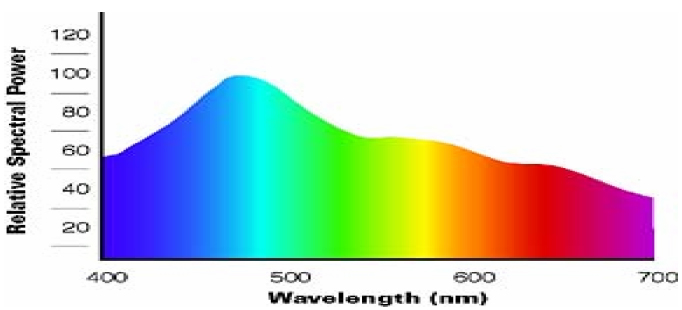
A theoretical spectral power distribution (SPD) graph of CIE D65
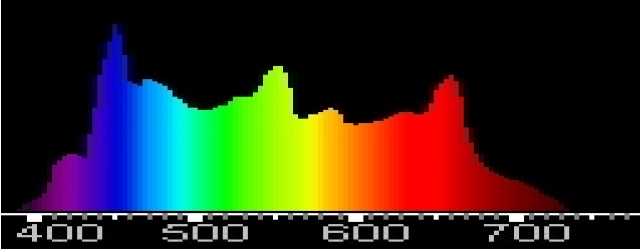
An actual SPD graph of an Ideal-Lume Pro D65 bias light

An actual SPD graph of a typical household incandescent lamp
The preceding SPD graphs demonstrate how different the color spectrum can be between the lighting used in the reference viewing environments versus what is used in the average home. Residential lighing will skew or contaminate a viewer's perception of objects and images illuminated by them. Of particular note is the fact that home-type incandescent lighting is often electrically dimmed when TV programs are viewed. Dimmed incandescent lamps become even warmer in color temperature, which results in a spectral content that becomes even more red-dominant. Typical viewers will find color TV pictures look more natural when displayed in a room that uses ambient lighting with the same specturm as video white (CIE D65)
- SMPTE recommends the level (brightness) of ambient lighting should be no greater than 10% of the brightest white produced in the video image on the display. Most users of video displays do not have access to the expensive spot-type luminance meters required to accurately measure both the display and the illumination on the wall behind it. This level can be identified using standard test patterns included in most home theater setup DVDs, such as ‘Digital Video Essentials’ by Joe Kane Productions.
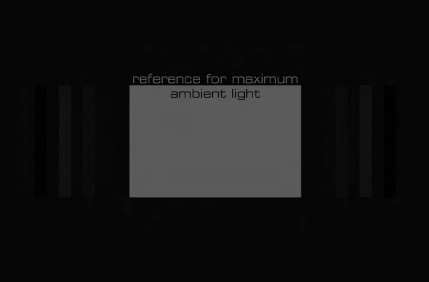
This is the test pattern from Joe Kane Productions’ ‘Digital Video Essentials.’
The TV’s picture controls should be set for dark room viewing, the test pattern is then displayed on the screen while observing the level of illumination on the wall behind the display.
- Bias lighting can also enhance the perception of black levels in the image. This is particularly helpful for TVs that have difficulty producing satisfactory blacks on the screen. An effective demonstration of how this works can be found at: http://www.lottolab.org/ (enter the "lab," click the "Illusions" button, and note particularly the "Brightness" demonstrations.) The following image is a good example of this perceptual phenomenon.

The horizontal bar in the center of the gray gradient field is the same shade of gray all along
its length. As the background changes to a lighter shade, the bar appears to darken.
- Room surface colors are important in a viewing environment. SMPTE recommends neutral colors for areas surrounding the TV. This promotes correct color perception for the viewer. Human factors research has shown that conflicting colors within the field of view while observing the screen can distort the perception of colors in the image. Neutral colors are gray to white. An excellent demonstration of how conflicting colors surrounding an object of focus can alter human perception is found at: http://www.echalk.co.uk/amusements/OpticalIllusions/illusions.htm (Note particularly the "Colour perception" and "Colour perception 2" demonstrations).
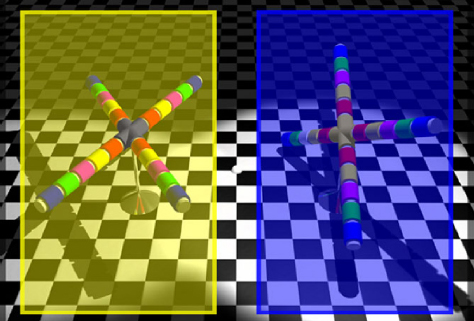
This image from the eChalk site was designed by Prof. R. Beau Lotto to illustrate how easily
influenced our color vision is. The center segment on both objects is exactly the same color.
A color analyzer would indicate that the segments are identical. Visually, they will
not look the same until a mask covers the surrounding colored areas.
- Room surfaces outside the observer’s field of view can incorporate nearly neutral colors to add more interest to the décor when desired. SMPTE uses the Munsell Color Order System for reference in defining ‘nearly neutral.’ Munsell Color samples can be found at: https://cinemaquestinc.com/ideal_viewing.htm

- Seating locations relative to the screen must be carefully considered. SMPTE recommends ideal viewing angles for primary seating to be within +/-15 degrees of the centerline of the screen on the vertical or horizontal axis. Professional cinema screening rooms sometimes incorporate a vertical viewing angle that places the center of the screen 12 degrees below horizon for maximum viewing comfort. This is difficult to maintain in most viewing environments, but the higher one places the screen the more fatigue will be experienced. A display’s viewing angle performance must be taken into account as well. The brightness and color uniformity of the image will diminish with many displays, as a viewer moves farther off axis. Plasma displays and certain types of front projection screens offer superior off-axis performance.
- Viewing distances are also important for optimum perceived image quality. Standard definition images look best at a minimum distance of around 5 to 6 times the screen height. DVD programs can be viewed a bit closer, especially if up converted to a higher resolution. High definition programs that are 1280 x 720 pixels can be viewed at about 3 ½ to 4 screen heights. Programs of 1920 x 1080i material allow a distance of about 3 screen heights, and 1080p a bit closer. These are averages, based upon typical human visual acuity. The objective is to perceive a sharp, smooth image, free of pixel definition (sometimes called the screen door effect) and visibility of imaging defects or artifacts. The Imaging Science Foundation has suggested providing 3 rows of chairs in multi-seat theaters. The first row would be used for high definition programs, the middle row for standard definition DVD programs, and the back row for NTSC standard definition programs.
- Room elements should not serve as distractions while watching programs on the screen. Of particular concern are reflective objects that light up along with changes in image brightness on the screen. Moving objects, like clock pendulums, etc., should not be within the field of view with the screen. Lights and displays from electronic components are best covered by cabinet doors or located outside the observer’s field of view.
- SMPTE also recommends that smaller monitor screens be located away from the wall behind, to aid viewing comfort during extended viewing sessions. They specify a minimum distance of 2 ½ times the screen’s height. This is also difficult to provide in many viewing environments, especially with wall mounting of flat panel displays currently in vogue.
FOR FRONT PROJECTION DISPLAY SYSTEMS:
- Many of the principles above should be intelligently applied to front projection viewing environments. Most critical is room lighting and surface colors. The only light that should reach the screen is that from the projector. Ambient lighting in the room should be tightly controlled or eliminated. Room surfaces should be dark and absorptive or non-reflective. Any light that strikes the screen or is reflected back to the screen will contaminate black levels, reduce image contrast, and reduce color saturation.
- Screen brightness can be overdone. Too bright of an image may induce eyestrain during extended viewing sessions and necessitate backlighting of the screen. This is very difficult to implement without light reflecting back onto the screen from room surfaces. High gain projection screens typically present their own compromises to image quality, such as hot spots and color shift.
- Room surfaces should be a dark color that is neutral or nearly neutral. A flat black ceiling is highly recommended because the ceiling is usually the closest reflective room surface to the screen. Keep in mind that large areas of vivid colors can reflect tinted light back onto the screen. This can contaminate the image
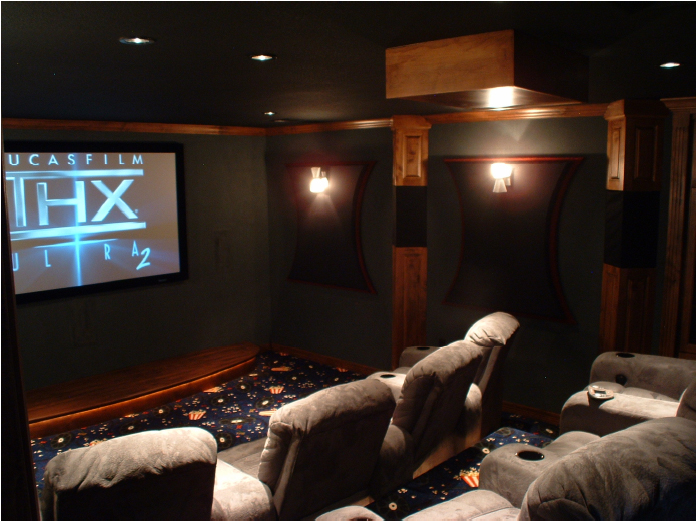
An example of good front projection viewing environment design
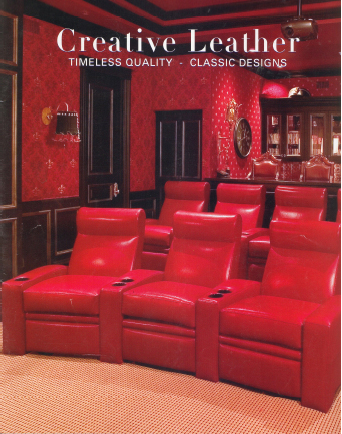
An example of poor design, if image fidelity is paramount
Finally, these principles are recommended for achieving reference imaging and optimum viewing comfort. Residential viewing environments often present various compromises to ideal conditions. Simply keep in mind that the closer one can come to these imaging recommendations the better. The farther one deviates from these principles the more image fidelity and viewing comfort will be compromised.
Be advised that most home theater builders, architects, interior designers, and consumers do not understand imaging industry standards and recommended practices. Least understood are human perceptual factors and video viewing environment priciples as they affect system performance. Most systems depicted in magazines and that win awards are celebrated for how they appear with all the lights on, not for how they perform when the lights go out and the show begins. Uninformed preconceptions, opinions, fad, fashion, whim and impulse can result in serious consequences to system performance.
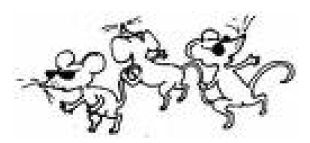
A viewer who values artistic integrity and image fidelity most will insist that the home theater or display system faithfully convey a video program as it was originally intended to be experienced. Viewing environment conditions play a vital and integral role in total system value, performance and audience experience.
![]()
